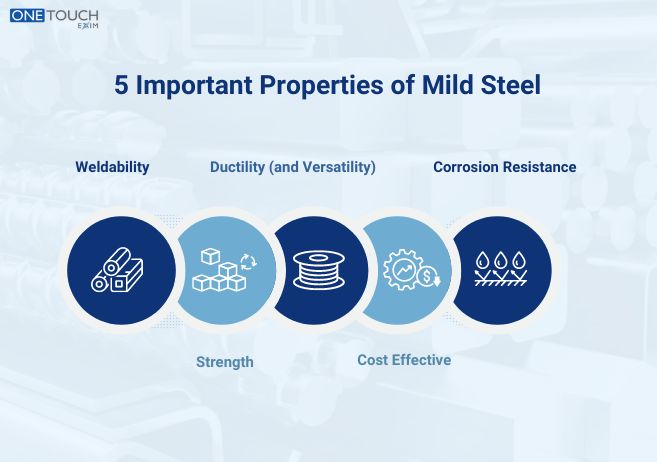Steel is a mixture of iron and carbon. It is used for making bridges, utensils, buildings, railway tracks, tools, ships, electrical appliances, weapons and manufacturing gate and so on. Iron is the base metal of steel. Steel is available in different types such as crucible steel, carbon steel, tool steel and high speed steel etc. This is an informative blog, which states that an element can possess properties like strength, ductility, weldability, machinability, Versatility, cost-effective, corrosion resistance, electrical and thermal conductivity etc. In this particular blog, We are going to explain five properties of mild steel.
What is Mild Steel?
Mild steel is type of steel which contains many elements such as carbon, iron, sulphur, manganese, phosphorus, silicon and so on. It is also known as low-carbon steel. It is cheap in cost comparatively alloy steel and from its versatility it is mostly used in construction work. It is used in the construction of buildings, bridges, agriculture equipment, piping, tubing, appliances and so on. It is also used in the manufacturing field, in automotive and other industries. Mild steel are different types such as structural steel, carbon steel, low carbon steel, and galvanized steel.
5 Important Properties of Mild Steel
Following are some properties of Mild Steel:
1. Weldability
Mild steel has excellent weldability. It is strongest and durable in weld because of its low carbon content. It is easy to join by variety of welding technics such as arc welding, TIG welding, and MIG welding. The weldability of mild steel depends on which type of steel is used. Weldability, Weldability is also depend on the grades of steel, the hardness of steel. Mild steel has different types of grades such as AISI/ S A E standard, ASTM standard, E N standard, ISO standard, JIS standard and so on. This weldability is good for joining the metal with each other.
2. Ductility (and Versatility)
Mild steel is highly ductile, which means it can be bent, shaped, or formed without breaking or cracking. This property makes it an ideal material for manufacturing parts that require precise shaping or forming, such as engine components, gears, and other mechanical parts. The high ductility of mild steel also allows it to absorb significant amounts of energy without breaking or cracking, making it suitable for applications where impact resistance is important. It is also used in for making platens, jigs, welding table springs, gears, and so on.
3. Corrosion Resistance
The other property of mild steel is corrosion resistance. The corrosion resistance of mild steel is not very high comparatively to other steels. But it give the good protection against the rusting when moisture and humidity in environments. From this property it is used in for making bridges, building, platens, fixtures and welding tables and is also used in machine elements such as springs, gears and bearings. The bonding of mild steel and protective coating helps to increase its corrosion resistance. To extend the life of mild steel by using the process of pickling. We remove the rust, scale, stains, and scale. from mild steel by this chemical process. The oxide layer is protect the mild steel from rust on the surface of the metal,
4. Strength
Mild steel is popular for its strength. It is not stronger comparatively alloy steel and carbon steel. But it is good in many products from its strength. It helps to give sufficient structural integrity and capacity of load-bearing. The strength of mild steel depends on the grade of steel, ductility, amount of carbon, and other hardening agent. The hardness of mild steel is mainly depend on the amount of carbon from this steel is much stronger than iron. When iron and carbon are join with pure iron then the the strength of mild steel is increased. The fatigue resistance of mild steel is very good it means it handles the extreme without any lasting damage.
5. Cost Effective
Mild steel is very cheap and cost-effective compared to other steel such as stainless steel or tool steel, because it does not contain any additional element in it. Many company and industries use this steel for construction work, due to its low cost.
Conclusion
Mild Steel is a versatile and widely used type of steel due to its combination of properties. Its ductility, corrosion resistance, strength, magnetic properties, and cost-effectiveness make it an ideal choice for a wide range of applications. While it may not have the same level of performance as other types of steel, Mild Steel is an excellent choice for many applications where its properties are sufficient.
